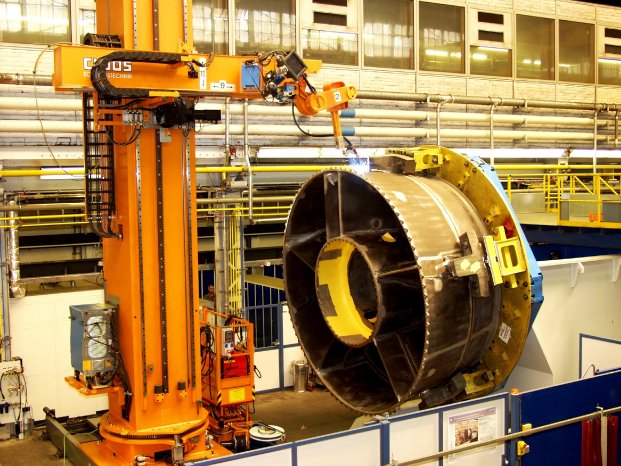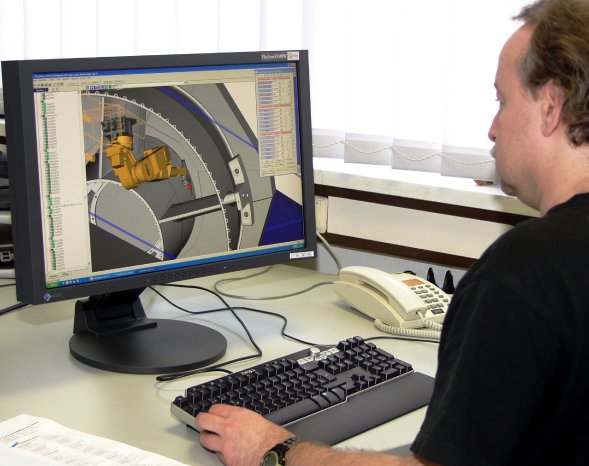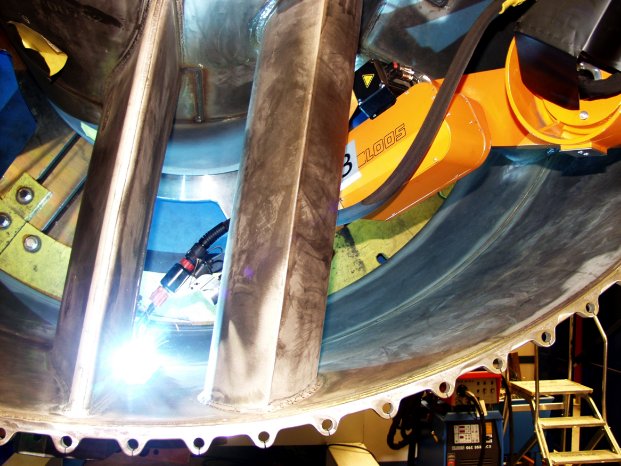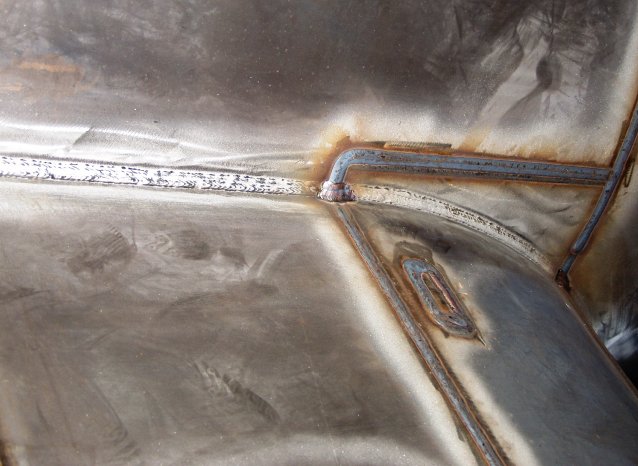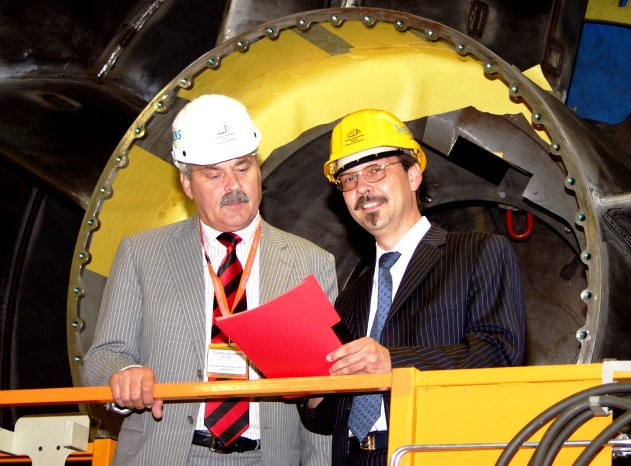The worldwide hunger for energy is continuing to increase. In particular, environmentally friendly energy producing processes are in great demand. In the case of the large power stations, production of electricity by means of gas turbines is the way forward, like the ones Siemens is producing in the Berlin factory. In particular, countries with natural gas fields would increasingly convert gas and sell the electricity abroad. This would earn more money and continue to develop the infrastructure of the supply countries.
The currently most efficient Siemens gas turbine supplies a fantastic 340 megawatts and is the biggest and most efficient gas turbine in the world. "This could supply electricity to the population of a town like Hamburg," explains Jörg Völker, manager of the Market Communication and Information sector. Siemens is leading in this field of electricity production. The demand is just as big. "Looking at our total portfolio, we are fully booked for three years", Völker says with pleasure. The factory in the capital can look back over a tradition of technology going back more than 100 years. In those days AEG built steam turbines there, since the 1970's Siemens has been producing gas turbines with around 2000 employees for the international market.
Keep the site in Germany competitive
Despite overflowing order books the manufacturer is going down the route of only buying in groups of components selectively and or manufacturing particularly demanding components itself. Nevertheless, in order to be able to build more gas turbines, Siemens is constantly improving its production and invested recently, for example, in a modern robotic welding system. "With the core competencies of welding technology plus robotics, CLOOS has placed itself in a very good position and proved itself as a reliable system partner" sums up Jerry Klopf, manager of the Housing Production in the Siemens factory in Berlin. In fact it was necessary to weld the 30 ton heavy end piece of the gas turbines - in professional jargon known as "lining the turbine bearing housing" - considerably more quickly.
"We used to weld the approx. 340 m long fillet and V-seams by hand, which took a bit out of our employees physically", Jerry Klopf points out a further aspect. Furthermore, the processing quality needed to further improve, to minimise re-working of the weld seams. The success shows in the figures: The CLOOS robot reduces the welding time from 114 to 80 hours. And re-working dropped clearly by over 10%. "After ten welded linings for the turbine bearing housings, we know that we have made the right decision with the CLOOS technology", of this Messrs. Klopf and Völker are certain.
The Robot moves on a C-Column
For optimum welding of the large turbine parts with up to 4 m diameter and 2 m depth, CLOOS has fitted the ROMAT® 350 robot to an almost 10 m high C-column. With the floor, height and transverse travel elements as well as a turn-tilt table working together, the supple robot can reach over 80% of the weld seams in the complex 30 ton component. The mechanically very stable ROMAT® robots are designed as swivel joint constructions and have at their disposal over 6 axes of rotation. Type 350 has, in addition, an extended 3rd axis with over 2,200mm reach for optimum accessibility to these large volume components. Dynamic servo drives enable a high load-bearing capacity of 15 kg and the precise compact gears ensure high repeat accuracy of under 0.1mm. The ROTROL® II controls the 6 robot axes as well as up to 12 further external axes, for example of the positioning unit.
"With our CAD component data CLOOS has already simulated, parallel to the development and production of the robot system in Haiger, the position and the quality of the weld seams for programming the control", according to Jerry Klopf. This clearly shortened the commissioning period, since only a few programme changes to the original part had to be made, in order, for example, to be able to take the various pieces of equipment on the site into consideration. "The robot and positioner are so supple that only 20% of the work has to be finished by hand." For this Siemens has ordered a special work platform, which can take the system personnel up to an airy 6.5m high.
MAG-Process for firm stainless steel connections
Fillet and V-seams are usually welded in three layers in the MAG process. In order to achieve the optimum results in this arc welding process, the melting welding wire is continuously fed according to the weld form and the weld speed via the CLOOS-Duo-Drive at changeable speed. Furthermore active gas components are in addition mixed with the inert gas, in order to influence the weld joint according to special technical requirements. Siemens uses a gas mix of 78% argon, 20% CO2 and 2% He to firmly join thick wall parts made of stainless steel. A tactile sensor secures the beginning of the seam. "And an arc sensor ensures the seam tracking and controls the weld head so that we do not have to exert ourselves any more for the preparation of the seam and the width of the gap", emphasises Jerry Klopf.
The high weld power is supplied by the welding power source Quinto GLC 603, which, with a maximum power up to 600 A has sufficient output reserves at its disposal. An extremely fast adjustment and a microprocessor control for programming the characteristics are the basis for optimum setting of the equipment according to material and weld seams. All information can be found by the operator in clear text on a large LCD display. The practical hand wheel ensures a simple and rapid in-put possibility for parameter sets, of which up to 20,000 can be stored. "The quality, once programmed, can thus be recalled at any time" according to the production specialist Jerry Klopf.
Training robot for welding tests
In order to comprehensively prepare the Siemens employees in respect of the new production technology, the CLOOS branch in Berlin made a demonstration robot available to gas turbine specialists. "On this we could train how to use the robot and find the optimum parameters" explains engineer Klopf. "This also contributed to smooth commissioning." The flesh and blood colleagues quickly grew fond of the robot and affectionately call him "Elke". Due to the positive experience with the CLOOS technology, Siemens bought the test robot and today uses it for further welding tests and development.
The summary of the Siemens specialists is clear: "We impressively show that the location in Germany is most certainly internationally competitive, since we have efficient production technology, core competencies and highly motivated personnel. And in matters of weld technology CLOOS contributes to a significant share of this success."
Full output in only 15 minutes
Siemens is currently building gas turbines in output classes from 68 to 340 megawattts. A 340 MW-gas turbine weighs 440 tons and is a good 13 m long and 5 m high.
Compared with coal and nuclear power stations these turbines have the advantage of higher level of efficiency and good adjustability. In only 15 minutes a power station such as this can reach full output. The generator as a motor drives the main turbine shaft. Through this the multi-stage compressor with its many high precision blades produces a certain air pressure. When the gas lights, the turbine continues to run independently up to its maximum revolutions and drives the generator.
The hot almost 600° exhaust gases are used to produce steam via a heat exchanger which is used in a steam turbine, subsequently switched on, to produce electricity as well. The high level of efficiency of the gas turbine of almost 40% then increases to a total efficiency level of 60%.
Furthermore the Siemens turbines appear to be relatively resistant with regard to the primary energy bearers: the most varied qualities of gas and oil can be used to produce electricity. In the future it will also be possible to use gas obtained from coal.
